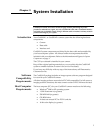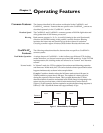
10 CoolSNAP
cf
/CoolSNAP
ES
If the exposure time is 50 ms, which is less than the readout time, the camera
operates in "nonoverlapped" mode (see Figure 2). The effective frame rate for
this is 7.14 fps (1/[0.05+0.090]). While in normal mode, the camera firmware
automatically calculates the readout times, taking into account binning and/or
subregion, and carries out the exposure-readout sequence to maximize the
frame rate.
Exposure
Readout
50ms
90ms
90ms 90ms 90ms 90ms
50ms 50ms 50ms 50ms
50ms
Figure 2. Normal Mode, Nonoverlapped
Alternate Normal mode
In "Alt-Normal", it is possible to achieve higher QE in the NIR (peak QE of
approximately 65%) by manipulating the CCD clock voltages. Also, in this
high-sensitivity mode, the preamplifier is switched off during the exposure to
eliminate the background generated by preamplifier glow. In this clocking
mode, irrespective of what the exposure time is, the camera operates in
"nonoverlapped" or "sequential" mode.
alternate-normal - high sensitivity
normal - high frame rate
70
60
50
40
30
20
10
0
Wavelength (nm)
200 300 400 500 600 700 800 900 1000 1100
QE (%)
Figure 3. QE for Normal and Alternate Normal Modes
Antiblooming
Typically, interline CCD devices are designed with antiblooming capabilities. To
prevent excess electronic charge from migrating to adjacent pixels, "drains" are
built into the CCD. These drains remove any excessive charge generated from an
overexposed pixel. Sony interline CCDs will prevent blooming for optical
signals greater than 1000 times the full-well capacity of a single pixel. However,
the extended QE capabilities of the Sony ICX285 in the CoolSNAP
ES
reduce the
antiblooming suppression for certain modes. In normal mode, the CCD operates
with typical antiblooming suppression. But in alternate normal mode, the
enhanced sensitivity causes a reduction in antiblooming to greater than 100
times single-pixel full-well capacity.


















